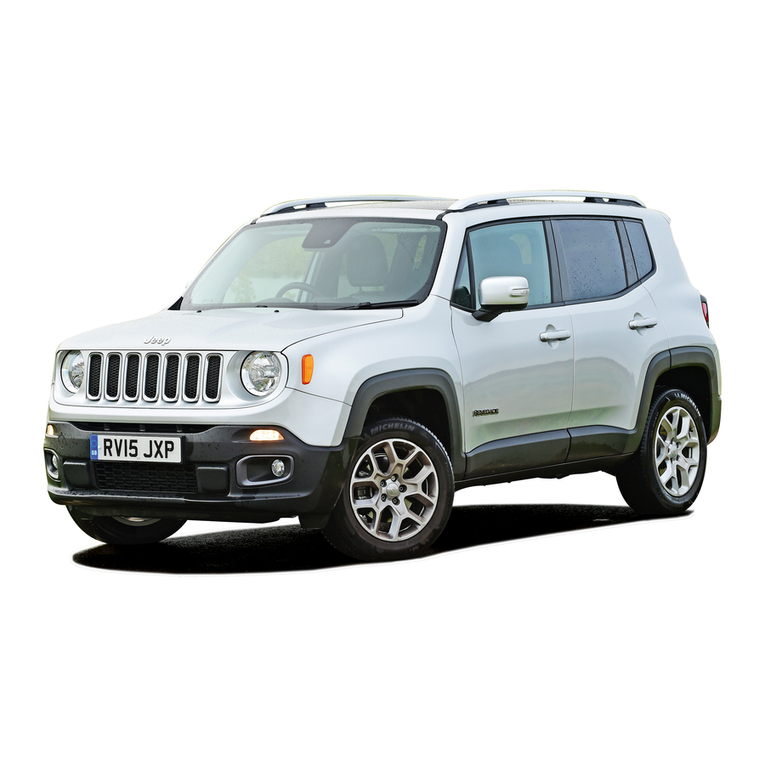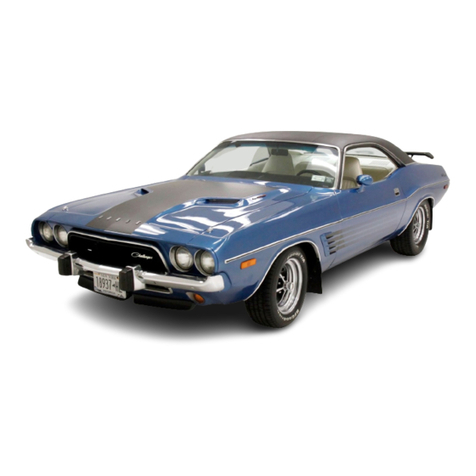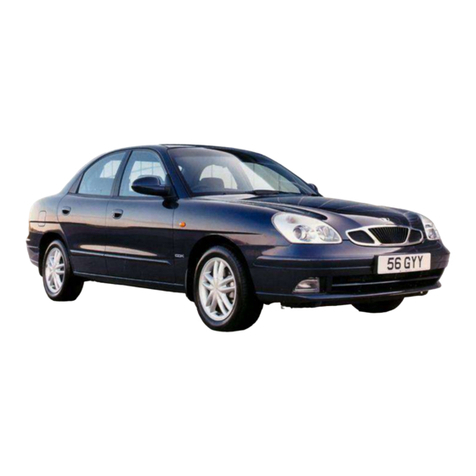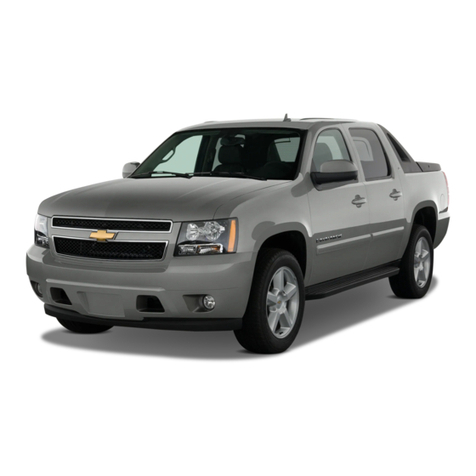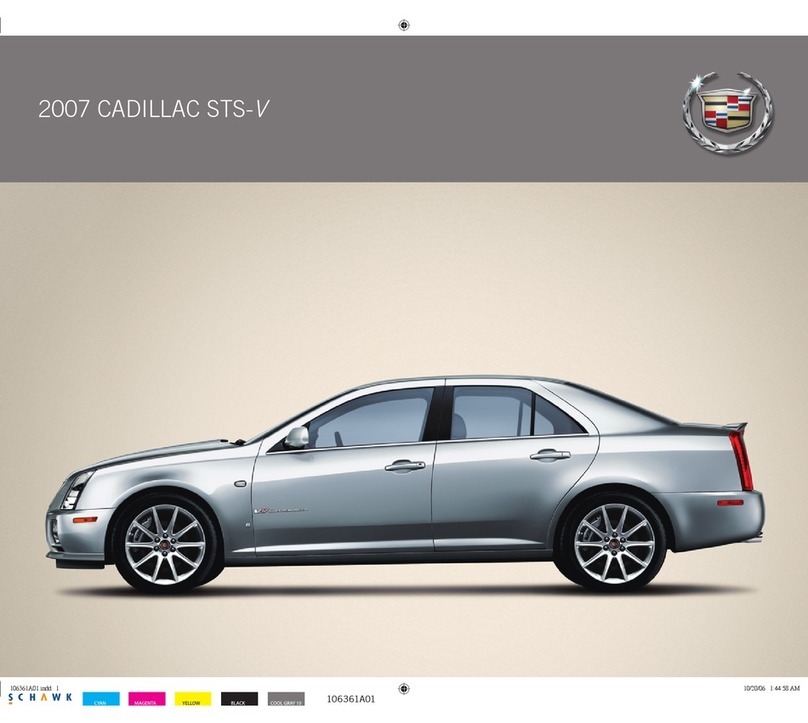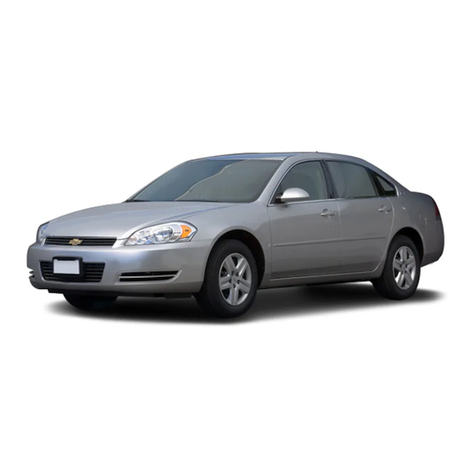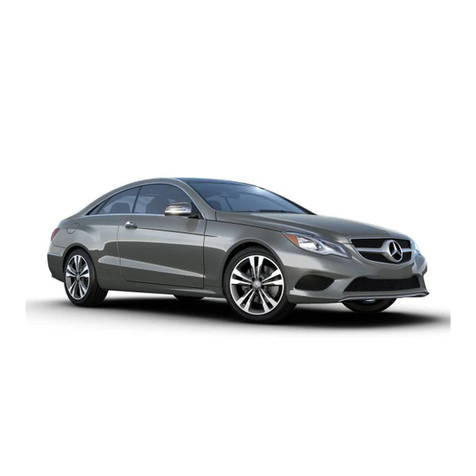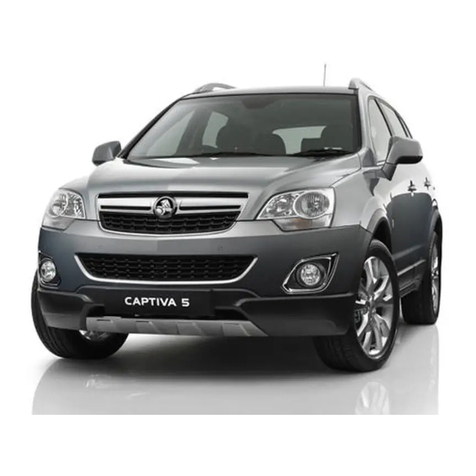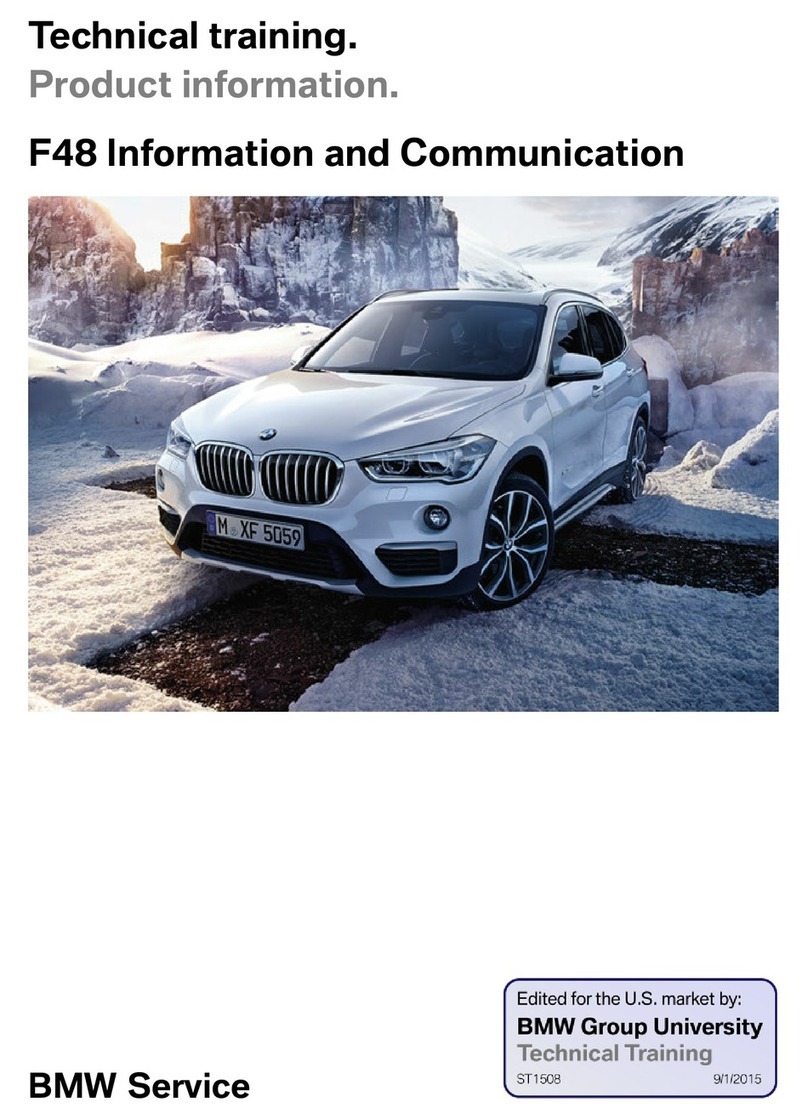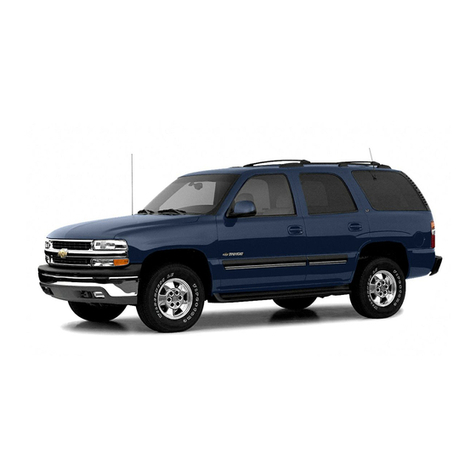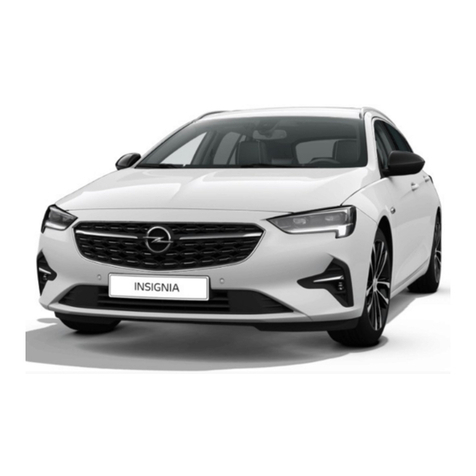Great Wall Florid 2008 User manual


PREFACE
GWFLORID will build 1.3L (GW413EF, GW4G13) or 1.5L (GW4G15) gasoline engines, in which the
GW4G13 and GW4G15 engines will both incorporate the newest VVT technology which meets the Euro IV
emission standards. GWFLORID features McPherson technology on its chassis system. With an ultra light
body made from structural steel and high-intensity front and rear fender impact beams as well as a collision
impact absorption system, it is able to maintain the cab's integrity and safety to greater extent. We wrote this
maintenance manual in order to meet the demand of Great Wall after-sales service technicians. This manual
mainly introduces the areas of importance in regard to maintenance and care, and removal and installation of
each system's assembly and maintenance technical parameters.
To reduce the possibility of injury or property damage, read and follow the instructions carefully:
This manual is provided by the Great Wall Motor Co., Ltd, and is written for the technician use. Any
maintenance or repair without proper prior training and tools or devices may result in personal injury of the
person performing the maintenance or others in the vicinity. It is also possible that damage to the vehicle will
occur or will lead to mechanical failure during normal operation.
Correct vehicle maintenance and repair is essential for the safety of the person performing regular
maintenance as well as the vehicle itself. If there is any component that needs to be replaced, use a
component with the same serial number or a serial number specied by the Great Wall Motor Co., Ltd. Never
use any part that has not been authorized by the Great Wall Motor Co., Ltd.
Any maintenance procedure introduced in this manual is effective for maintenance and repair. Some of
these procedures need specially designed tools.
Therefore, before using any vehicle part following any maintenance procedure or working with a tool
that has not been authorized by the Great Wall Motor Co., Ltd, check to make sure that none of the above
will endanger the safety of the person performing the work or the correct operation of the vehicle.
This manual includes multiple "Warnings" and "Cautions," which should be strictly followed, so as to
reduce the possibility of injury during maintenance or repair. Improper maintenance or repair of the vehicle
may cause potential safety hazards. These "Warnings" and "Cautions" are not exhaustive. It is impossible for
the Great Wall Motor Co., Ltd, to warn against all the potential dangers caused by not properly following the
instructions.
Please read carefully the "Areas of Importance" before carrying out any maintenance or repair on the
airbag system's components or its surrounding electrical components. Action contrary to any of the "Areas of
Importance" may lead to the deployment of the airbag, resulting in injury or unnecessary repair of the airbag.
To avoid accidental deployment of the airbag and its resulting injury, we suggest repairing the airbag
system before other vehicle systems if the airbag and the other vehicle systems both need repairing.
We have received generous support and help from many professional technicians during the preparation
of this manual. We would like to express our heartfelt gratitude to all of them.
Although we have tried our best to write this manual well, we do not guarantee that the entire content
in this manual is absolutely correct. Users may not make any legal claim against the Great Wall Motor Co.,
Ltd. in regards to this manual. Any loss caused by using this manual is not our responsibility. Because of
the writer's limited experience, there are likely mistakes in this manual, therefore we welcome any user
comments, suggestions, and corrections.
Great Wall Motor Co., Ltd. reserves the nal right of explanation.
Editor
May 2008


Chapter One: Overview................................................................................................................1
How to Use This Manual..............................................................................................2
Identifying Number Location ........................................................................................3
Comprehensive Repair Instructions.............................................................................4
General Repair Methods and Operations ....................................................................9
Chapter Two: Overall Parameters ..............................................................................................10
Basic Parameters of the Overall Vehicle ...................................................................11
Engine Technical Parameters ....................................................................................12
Chassis’ Main Assembly Technical Parameters.........................................................13
Vehicle Structure Type and Parameters ....................................................................15
Air Conditioning System Structure and Parameters ..................................................16
Electrical System Structure and Parameters .............................................................16
Grade Specication and Filled Quantity of Each
Individual Functioning Component’s Working Agent..................................................18
Torque Specications for Key Operational Bolts........................................................18
Vehicle Body’s Basic Calibration Measurements ......................................................22
Chapter Three: Fuel Supply and Exhaust System .....................................................................29
Fuel Supply System...................................................................................................30
Components ............................................................................................................30
Fuel Tank Removal ..................................................................................................31
Fuel Pump and Charcoal Canister Removal ...........................................................31
Fuel Filter Removal..................................................................................................31
Fuel Filler Pipe Assembly Removal .........................................................................32
Exhaust System.........................................................................................................33
Components ............................................................................................................33
Exhaust System Removal........................................................................................34
Exhaust System Installation.....................................................................................35
Chapter Four: Clutch Operational System..................................................................................36
Areas of Importance ..................................................................................................37
Troubleshooting .........................................................................................................37
Clutch Operational System ........................................................................................38
Components ............................................................................................................38
Clutch Master Cylinder Removal .............................................................................38
Clutch Master Cylinder Installation ..........................................................................40
Clutch Pedal Removal .............................................................................................40
Clutch Pedal Installation ..........................................................................................40
Clutch Pedal Examination and Adjustment..............................................................41
CONTENTS

Chapter Five: Transmission........................................................................................................42
037A Transmission’s Overall External Schematics....................................................43
Main Technical Parameters ......................................................................................43
Transmission’s Proper Use and Care ........................................................................44
Technical Specications for Transmission Installation and Adjustment .....................44
Areas of Importance ..................................................................................................45
Troubleshooting .........................................................................................................46
037A Transmission Structural Schematics ................................................................47
Clutch.........................................................................................................................48
Gear Shift Fork and Fork Shaft..................................................................................49
Transmission Case ....................................................................................................50
Disassembling the Input Shaft Subassembly ............................................................56
Disassembling the Output Shaft Subassembly..........................................................60
Disassembling the Shift Cover Subassembly ............................................................64
Disassembling the Differential Subassembly.............................................................68
Chapter Six: Suspension System...............................................................................................71
Suspension System Technical Parameters ...............................................................72
Front Suspension.......................................................................................................73
Subframe and Front Stabilizer Bar ............................................................................77
Lower Swing Arm.......................................................................................................80
Drive Shaft .................................................................................................................84
Rear Suspension .......................................................................................................86
Wheel and Tire...........................................................................................................89
Chapter Seven: Brake System ...................................................................................................94
Brake System Components Arrangement Schematics..............................................95
Brake System Maintenance.......................................................................................96
Brake Pedal ...............................................................................................................98
Parking Brake Control Mechanism Assembly..........................................................102
Vacuum Booster with Brake Cylinder Assembly ......................................................103
Anti-lock Brake System............................................................................................107
ABS General Problem Maintenance and Areas of Importance................................109
Steering Knuckle and Hub Brake Assembly ............................................................112
Front Brake Caliper..................................................................................................118
Rear Brake...............................................................................................................124
Rear Support Axle....................................................................................................131
Chapter Eight: Steering System ...............................................................................................134
Troubleshooting .......................................................................................................135
Steering System Maintenance.................................................................................137
Power Steering Fluid Instructions ............................................................................141

Technical Requirements ..........................................................................................141
Chapter Nine: Vehicle Body Electrical System.........................................................................142
Basic Information on the Electrical System .............................................................143
Fuse Box..................................................................................................................144
Overall Vehicle’s Grounding Point Schematics........................................................150
Key Electrical Component’s Module Schematics for the Overall Vehicle ................151
Wire Harness Distribution Chart for the Overall Vehicle ..........................................152
Wire Harness Relationship and Plug-in Connections Numbered Diagram..............155
Wire Harness Plug-in Connectors and Pin Function Diagram.................................156
Electrical Wiring Diagram for the Overall Vehicle ....................................................167
Chapter Ten: Electrical Accessories .........................................................................................177
Reverse Sensor .......................................................................................................178
Combination Meter ..................................................................................................180
Central Door Lock....................................................................................................181
Power Windows .......................................................................................................184
Immobilizer System .................................................................................................186
CD Player ................................................................................................................193
DVD Player ..............................................................................................................195
Chapter Eleven: Air Conditioning System................................................................................202
Areas of Importance ................................................................................................203
Technical Parameters ..............................................................................................203
Troubleshooting .......................................................................................................204
Air Conditioning System’s Structure Diagram and Fundamentals...........................207
Air Conditioning System Overview ..........................................................................207
Air Conditioning System Terminal Denition............................................................208
Compressor .............................................................................................................208
Electromagnetic Clutch............................................................................................210
Vacuuming and Charging Refrigerant......................................................................211
Filling Quantity and Method for Refrigerant Oil........................................................212
Daily Maintenance of the Air Conditioning System .................................................212
Chapter Twelve: Airbags...........................................................................................................213
Airbag Electronic Control Unit..................................................................................214
Diagnostic Scanner..................................................................................................215
Troubleshooting .......................................................................................................216
Vehicle Collision Diagnostics ...................................................................................226
Removal Method for Individual Components...........................................................227
Driver Side Airbag Module (DAB), Front Passenger Side
Airbag Module (PAB), Clock Spring, and Steering Wheel .......................................228
Airbag Module Disposal...........................................................................................230

Airbag’s Diagnostic Methods Without a Diagnostic Scanner...................................232
Chapter Thirteen: Vehicle Body................................................................................................233
Front Door Lock Assembly.......................................................................................234
Rear Door Lock Assembly .......................................................................................237
Trunk Door Lock Assembly ......................................................................................239
Wiper Arm and Vent Panel Assembly ......................................................................240
Front & Rear Window Glasses ................................................................................241
Dashboard ...............................................................................................................242
Cooling Unit .............................................................................................................246
Front Door Assembly ...............................................................................................248
Rear Door Assembly................................................................................................251
Trunk Door Assembly...............................................................................................254
Front Bumper...........................................................................................................256
Rear Bumper ...........................................................................................................259
Seat Belt ..................................................................................................................262
Seats........................................................................................................................266
Sunroof Assembly....................................................................................................268

1
Overview
Overview
How to Use This Manual .................................................... 2
Identifying Number Location............................................... 3
Comprehensive Repair Instructions ................................... 4
General Repair Methods and Operations........................... 9

GWFLORID Maintenance Manual
2
How to Use This Manual
1. There is a content index on the first page of each
chapter. You can consult the index to see the items
needed for maintenance. In order to make searching
more convenient, the subject of each chapter has been
printed on the page header of each odd page.
2. There is a summary or caution item in the beginning of
each chapter. Please read this content carefully before
any maintenance is performed. Some systems include
a malfunction diagnostic table to help determine ve-
hicle failures and their causes.
3. Throughout the entire manual, each maintenance
step's corresponding specification is highlighted in bold,
so there should be no need to pause maintenance
work in order to find these specifications.
4. Warnings, Cautions & Notes
• Warnings are highlighted in bold, indicating the possibility
of causing injury to oneself or to others.
• Cautions are highlighted in bold, indicating the possibility
of damaging the part being repaired.
• Notes are listed separately from the instructions, not high-
lighted in bold. They are mainly used for additional expla-
nations in order to work more effectively.
5. Maintenance procedures:
Most of the maintenance procedures begin with a high-level
component schematic, which indicates individual vehicle
components and how they are assembled.
For example:
Hollow bolt
Copper washer
Q150B1235
Heavy duty spring washer Q40512
Q43082
Front hub bearing assembly
Left steering
knuckle
Front brake disc
cover LH
Q1420612
Front hub flange
Front brake disc
Front brake caliper assembly LH
100±10
9±2
N·m : Specied torque
Disposable parts

3
Overview
Correct vehicle maintenance and repair is very important
to the safety of the maintenance person and the vehicle. If
any vehicle part change is necessary, please use a part with
the same part number or part number specified by the Great
Wall Motor Co., Ltd. Never use a part that has not been au-
thorized by the Great Wall Motor Co., Ltd.
4. Inspect the front brake disc thickness.
Standard thickness: 22.0 mm
Minimum thickness: 20.0 mm
The brake disc must be changed when its thickness falls be-
low the minimum level.
The maintenance procedures are explained step by step:
• The schematics and diagrams illustrate how and where to
operate.
• The titles convey the maintenance content.
• Detailed instruction explains how to perform the maintenance,
as well as introduces other related matters, such as specications,
warnings, and so on.
For example:
Illustration: How and where to operate.
Work Subject: What to do
Detailed Instruction: How to do it
Specifications
Engine Manufacturing Number
The engine manufacturing number is engraved on the left
side of the engine cylinder block.
Vehicle Nameplate
Every vehicle has a vehicle nameplate, and this vehicle's
nameplate is located at the bottom of the right B-pillar.
Identifying Number Location
Vehicle Identification Number (VIN)
A Vehicle Identification Number is a unique serial number
consisting of 17 characters and used to identify individual
motor vehicles. This number is marked at three different
places: at the nameplate, at the upper-left side of the dash-
board, and at the cross member located under the front pas-
senger seat.
VIN
Vehicle Nameplate

GWFLORID Maintenance Manual
4
Comprehensive Repair Instructions
1. Use the splasher, backing, and carpet to keep the vehicle
clean and to prevent damage.
2. While removing, mark all vehicle components or
place all the components in proper order to make re-
assembling more convenient.
3. Disposable parts:
(a) Always use new parts to replace cotter pins, gaskets, O-
rings, and oil seals.
(b) Disposable parts will be marked with a " " in the
components schematics section.
4. Precoated components.
The precoated components include bolts and nuts which
have been coated with locking sealant in the factory.
(a) If the precoated part is tightened, loosened, or moved
for certain reason, it must be coated with prescriptive
sealant again.
(b) When reused, the original sealant should first be
cleaned and dried using compressed air. Afterwards,
use the required locking sealant to coat the bolts, nuts,
or threads.
(c) Precoated parts are marked with " " in the components
schematics section.
5. All rules regarding a bolt's tightening torque must be
seriously obeyed, and a torque wrench must be used.
6. Be careful when using a jack to raise and support the
vehicle. Make sure to jack up and support the vehicle
at proper locations.
(a) To ensure safety, chock up the wheels of the opposite
side if the place to be jacked up is either the front or
back of the vehicle.
(b) After lifting the vehicle, make absolutely sure to
support it with a bracket. It's extremely dangerous to
perform maintenance using merely a jack, even if to
finish the small matter quickly.
Torque wrench indication type
Torque wrench scale indication type
Hydraulic jack Scissor type jack

5
Overview
The white side
The black side
7. Pay attention to the "Areas of Importance"below to
avoid damaging any part:
(a) Do not open the cover or case of the ECU (Electronic
Control Unit) unless it's absolutely necessary. (Touching
the pin of the IC (Integrated Circuit) may damage the
IC due to static electricity.)
(b) When unplugging the vacuum hose, make sure to pull
from the end of the hose but not the center.
Incorrect Correct
(c) To make hose reassembly more convenient, label the
unplugged portions for easier recognition later. After
performing this task, check carefully to make sure the
hose is connected correctly.
(d) Be careful! Do not drop any electrical components (like
sensors or relay connectors). Replace them at once
if they have been dropped onto a hard surface. They
cannot be used for the second time.
(e) When cleaning the engine with a steam, make sure to
properly protect the ignition coil and air filter as to
prevent water from seeping in.
(f) Do not forcefully try to connect a hose into an
oversized tube while using a vacuum gauge. Instead,
use a stepped connector. If the hose is stretched, it may
lead to leaking.
8. All resistors must be measured at below 20oC room
temperature unless special situations arise. This is
because resistance value measured under higher
temperature may
exceed standard requirements, espe-
cially if measured after driving the vehicle. All measures
should be taken after the engine has cooled down.
Circuit Maintenance Instructions
1. Rules to be obeyed before a circuit is repaired:
(a) Make sure to disconnect the negative (-) cable from the
battery before electrical maintenance is performed.
(b) When inspection and maintenance work requires
disconnecting the battery, make absolutely sure to
disconnect the negative (-) cable of the battery and that
it is connected to the vehicle body as grounding.
(c) To prevent damaging the wiring terminal of the battery,
loosen the cable's fixing nut and lift up the cable, but
do not forcefully twist or press the cable.
(d) When cleaning up the battery's and the cable's connecting
terminals, make sure to use a special rag, and do not use a
file or other rough material to wipe them.
(e) While connecting the connecting terminals of the cable
and battery, loosen the nuts first, then tighten them
after installation. Do not hammer the cable's connecting
terminals into the battery with a hammer.
(f) If the battery's ground cable has not yet been
disconnected, please do not try to speed charge the
battery, as this could damage the alternator's diode.
(g) Should the battery's ground cable be disconnected,
please do not try to start the engine, as this could
seriously damage the wire.
(h) Make sure to properly cover the battery's positive (+)
end cover.

GWFLORID Maintenance Manual
6
2. Inspection procedures for related fuses or fuses in re-Inspection procedures for related fuses or fuses in re-Inspection procedures for related fuses or fuses in re-
lay boxes. Inspect the battery for damage, the battery's
charging state, cleanness, and tightening with the
connectors.
Before changing a fuse, make sure to check if the fuse's cur-
rent rating meets the required standards. You must not use a
fuse with a current rate that is higher or lower than required
standards.
Same current rating
3. Binding wire harness connectors.
(a) When disconnecting the connections, first press the two
ends of the connectors together, then loosen the lock
and press the lock pawl to release the connector.
(b) When disconnecting the connector, do not pull on its
wire harness. Grasp the joint directly.
(c) Check if the joint is deformed, damaged, or port lost
before connecting the connector.
(d) The connector is not successfully connected until it
makes a click sound.
4. Wire harness connector inspection.
(a) Check while connecting the connectors.
Squeeze both ends of the connectors to make sure it is com-
pletely plugged in and tightly locked.
(b) Check when disconnecting the connectors.
Check by lightly pulling the wire harness behind the connec-
tor's joint. Look for any unconnected or dropped terminals,
loose clamps, or broken wires.
Visually inspect for instances of corrosion, metal fragments,
oddities, and water, as well as bending, rust, overheating,
pollution or deformed terminals, etc.
(c) Check the contact pressure of the terminals.
Prepare a plug that matches the connector's port, plug it into
the socket, then check for the proper rate of tension after
they are fully engaged.
Loosen crimp
Core
Deformed terminal
Pull lightly
The terminal is similar to a plug
Incorrect

7
Overview
Protection band
Screwdriver
5. Maintenance methods for wire harness connector ter-Maintenance methods for wire harness connector ter-for wire harness connector ter-
minals.
(a) Use an airgun or rag to clean the contact points if the
terminals become dusty. Do not use sandpaper to clean
it, as that could damage the electroplated layer.
(b) If the contact pressure seems unusual, change it to a
socket of the same type.
(c) Any terminal that has been damaged, deformed, or
corroded must be changed. If the terminal is not locked
to the case, then the case needs to be replaced too.
Correct Incorrect
6. Clip removal and installation.
Methods for removal and installation of the vehicle's body part clips are shown in the table below.
Remark: If the clip is damaged during operation, it must be replaced with a new one.
Shape Removal / Installation
Vise
Clip extractor
Protection band
Screwdriver

GWFLORID Maintenance Manual
8
Shape Removal / Installation
Continued table
Removal
Screwdriver
Installation
Press
Clip extractor
Push out the king pin, remove it,
and pry the kingpin bush.
Screw off the king pin and pry the shell.
Pry out the king pin, remove the rivet,
and then pry off the shell.
Removal
Screwdriver
Clip extractor
Press
InstallationRemoval
Screwdriver
Press
Small clip extractor
Installation
Clip extractor

9
Overview
General Repair Methods and Operations
1. If a jack is needed, please kindly comply to the safety procedures listed below.
2. Park the vehicle on a flat surface, stablize the front and the back wheels using any fixed object or tool,
jack up the vehicle, support it with the chassis, and then start the maintenance.
3. Disconnect the battery's negative cable before maintenance, in order to reduce the possibility of
damaging and burning out the cable due to a short circuit.
4. Cover the vehicle body, seats, and floor to prevent them from being damaged and polluted.
5. Handle brake fluid and antifreeze fluid carefully, because it may damage the vehicle's surface paint
and its surroundings.
6. Using the proper tools or basic tools that have been recommended and are purchasable is very
important in guaranteeing an effective and reliable maintenance result.
7. Dispose the used dowel pins, gaskets, O-rings, oil seals, lock washers, and self-locking nuts. Prepare
new parts for installation. Normal functions are not guaranteed if these parts are reused.
8. Store the removed parts in order and in groups to make reassembly more convenient.
9. Store bolts and nuts separately, because their hardness levels and designs are different according to
the installation locations.
10. Clean parts before they are inspected or reassembled. In addition, parts that come in contact with
engine oil also need to be cleaned, as well as checked for blockage by using compressed air.
11. Before installation, use engine oil or grease to lubricate the rotating and sliding sides of the necessary
parts.
12. When necessary, use sealant on gaskets to avoid leakage.
13. Please carefully comply to all tightening torque specifications of bolts and nuts.
14. After maintenance, check to make sure whether the repairs were performed correctly and whether the
malfunctions have been fixed.
Vehicle Lifting/Lowering Procedures
When lifting the vehicle, the lifter must be placed at the indicated spots. Using these indicated spots
incorrrectly can lead to permanent deformation of the vehicle body. Many vehicle service stations
have autolifts that raise vehicles by supporting certain vehicle parts. If using other types of lifts, be
careful to prevent damages to the fuel tank, oil filler, or the base of the vehicle body.
Frame contact lifting device and basic hand jack
Floor arch jack
Lifting points (left/right) of central threshold

GWFLORID Maintenance Manual
10
Overall Parameters
Basic Parameters of the Overall Vehicle ............................ 11
Engine Technical Parameters............................................. 12
Chassis' Main Assembly Technical Parameters ................. 13
Vehicle Structure Type and Parameters............................. 15
Air Conditioning System Structure and Parameters........... 16
Electrical System Structure and Parameters...................... 16
Grade Specication and Filled Quantity of Each
Individual Functioning Component's Working Agent .......... 18
Torque Specications for Key Operational Bolts ................ 18
Vehicle Body's Basic Calibration Measurements .............. 22

11
Overall Parameters
Item S08 S16 S12
GW413EF GW4G15 YC4W75-31
Size Pa-
rameters
(no load)
(mm)
Length 3907
Width 1694
Height 1521
Wheelbase 2368
Tread: front/rear 1459/1430
Front suspension 813
Rear suspension 726
Quality
Parameters
Load capacity (kg) 5 people × (68±7) kg/person
Curb weight (kg) 1135 1120 1118
Gross vehicle weight (kg) 1510 1495 1493
Unload axle load distribution: front/rear (kg) 646/434 669/451 689/429
Unload centroid location (x, y, z) (mm) 951/27/285.9 954/27/285.9 909/27/285.9
Full load axle load distribution: front/rear (kg) 748/707 770/725 791/702
Full load centroid location (x, y, z) (mm) 1151/22/375.5 1148/22/375.5 1114/22/375.5
Passing
Ability
Parameters
Minimum turning diameter (m) 11
Minimum ground clearance (mm) 127 (full load)
Approach angle (°) 17 (full load)
Departure angle (°) 20 (full load)
Breakover angle (°) 16 (full load)
Dynamic
Performance
Minimum stable speed of the direct gear (km/h) ≤25
Direct drive 25 km/h - 100 km/h acceleration
time (s) ≤32
Acceleration time from standstill with the first
gear to shifting gears until reaching 100 km/h (s) ≤19
Maximum speed (km/h) 162 178 152
Maximum climbing capacity (%) 30.6 34 34.3
Economy
Sliding distance (m) of 50 km/h initial speed ≥500
Fuel consumption of 90 km/h speed with
constant velocity (L/100 km) 5.79 6.1 4.25
Fuel consumption of 120 km/h speed with
constant velocity (L/100 km) ≤8.5
Under the urban and suburb driving cycle
simulation (L/100 km) ≤7.5 ≤8.1 ≤7.5
Braking
Performance
Service braking distance (m) of 50 km/h initial
braking speed 19.0≤ (no load) ≤ 20 (full load)
Emergency braking distance (m) of 50 km/h
initial braking speed ≤38
Grade braking (%) ≥18
Stability
Maximum angle of rolling stability when empty
or inactive (°) ≥35
Handling stability (min) Nan≥60 and NZ≥60
Basic Parameters of the Overall Vehicle

GWFLORID Maintenance Manual
12
Ride
Performance
Outter acceleration noise dB (A) ≤74 ≤75
60 km/h constant velocity interior noise dB (A) ≤65 ≤65
Driver operating noise dB (A) ≤90 ≤90
Emission
CO emission (g/km) ≤2.30 ≤1.00 ≤0.64
HC emission (g/km) ≤0.20 ≤0.10 /
NOx emission (g/km) ≤0.15 ≤0.08 ≤0.5
Particle emission (g/km) / / ≤0.05
Smoke density / / ≤4.0
Engine Technical Parameters
Item Unit Specifications and Parameters
Model number GW413EF GW4G15 YC4W75-31
Model
Inline four cylinder, 4-stroke, water cooling, dual
overhead camshaft, petrol engine
Inline four cylinder,
4-stroke, water cooled,
dual overhead camshaft,
diesel engine
Fuel supply type Electronic controlled, multi-points ordinal injection
High pressure electronic
controlled common-rail
fuel injection
Cylinder bore ×
stroke mm × mm 78.7 × 69.0 75 × 84.7 71.0 × 77.0
Displacement L 1.342 1.497 1.219
Compression ratio 9.3:1 10.5: 1 18.5:1
Number of valves/
cylinder 16/4
Lowest rate of fuel
consumption g/(kW·h) <260 ≤260 215
Maximum power/
rotation speed kW/(r/m) 65/6000 77/6000 50/4200
Max. torque/
rotation
speed
N·m/(r/m) 115/4400-5200 138/4200 153/2000-2400
Total net weight kg 115 96 142±2
Idle speed r/min 800±50 800 750±50
Fuel type and
grade RON/MON Unleaded gasoline, #93 Euro diesel fuel
Cooling style and
performance
parameters
Forced water circulation
cooling, the opening
temperature of the
thermostat is 82±2oC, the
water temperature under
normal working condition
is 90-100oC, the opening
pressure of the coolant
compensation box's
pressure limiting valve is
108±14.7 kpa
Forced water circulation
cooling, the opening
temperature of the
thermostat is 82±2oC, the
water temperature under
normal working condition
is 80-90oC, the opening
pressure of the coolant
compensation box’s
pressure limiting valve is
108±15 kpa
Forced water circulation
cooling, the thermostat
starts to open at 75oC and
is fully open at 85oC, the
opening pressure of the
coolant compensation
box's pressure limiting
valve is 108±14.7 kpa
Starting style and
performance
Motor starting, starting performance complies with GB18297
requirements 8.1.2 and 8.1.3
Lubricating
method Pressure and splash combination

13
Overall Parameters
Chassis' Main Assembly Technical Parameters
Item Specifications
Model number GW413EF GW4G15 YC4W75-31
Clutch Clutch type
Single chip, dry type, diaphragm spring Single chip, dry type,
diaphragm spring
Driven disc diameter:
200 mm
Clutch disc diameter:
213 mm
Driven disc diameter:
212 mm
Maximum stroke: 9 mm, separating stroke: 7.5 mm Separating stroke:
7.5 mm
Clutch hydraulic pressure
control system Clutch pedal total stroke: 116.5mm
Transmission
Transmission
model number 037A CC0011A ZM007Q ZM007W
Transmission type Mechanical 5-gear manual transmission
Main speed
reduction ratio 3.944 4.3125 4.267 3.937
Gear
transmission
ratio
1st gear 3.545 3.545 3.364 3.182
2nd gear 1.913 1.905 1.895 1.895
3rd gear 1.310 1.310 1.286 1.25
4th gear 0.973 0.970 0.969 0.91
5th gear 0.804 0.816 0.800 0.703
Reverse
gear 3.214 3.250 3.214 3.08
Maximum bearing
torque (N·m) 130 160 153 153
Maximum input speed
(r/min) 6000
Propeller shaft
The input end of the propeller shaft adopts a widely used, near constant
velocity, retractable spherical roller wheel joint. The output end adopts a
Rzeppa joint.
Air intake system Dry air lter, paper ltering element.
Exhaust system
Equipped with GW413EF engine, two grade mufer with two grade three-
way catalytic converter. Front/rear oxygen sensors.
Equipped with YC4W75-31 engine, two grade mufer with one grade three-
way catalytic converter and oxygen sensor.
Fuel supply system
Equipped with GW413EF engine. The 45L metal fuel tank includes an
electronic fuel pump and a charcoal canister. An electronic accelerator pedal
controls the fuel supply. The fuel evaporation control system controls the
charcoal canister through a solenoid valve
Equipped with the YC4W75-31 engine. High pressure electronic common-
rail fuel injection and dual fuel pipeline. The 45L metal fuel tank includes an
electronic fuel pump and a charcoal canister, electronic accelerator pedal, a
fuel line is connected with the fuel-water separator and diesel fuel lter.
Cooling system
The cooling system uses the enclosed forced water circulation cooling
system, the heat dissipating electronic fan uses a two level speed controller.
The electronic fan and overow tank are combined in one. The radiator is
equipped with upper and lower water chamber aluminum pipe. The system
pressure is 90 kPa.
This manual suits for next models
1
Table of contents
Other Great Wall Automobile manuals


